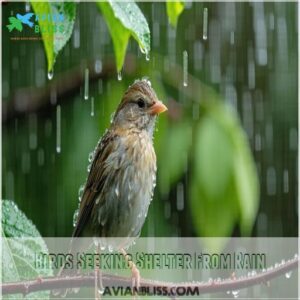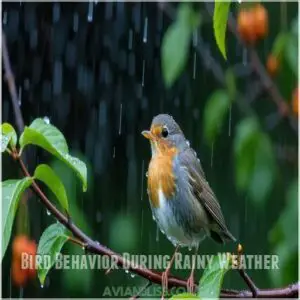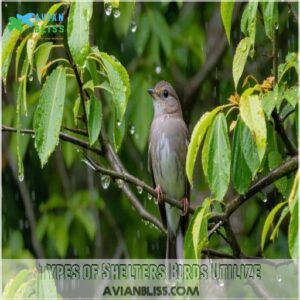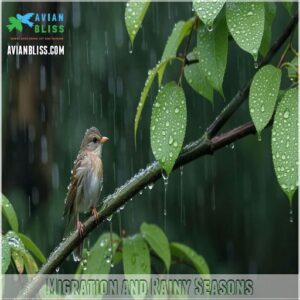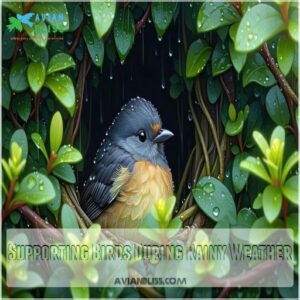This site is supported by our readers. We may earn a commission, at no cost to you, if you purchase through links.

They’ve mastered the art of staying dry, using their waterproof feathers and natural shelters to wait out the storm. Some species huddle together in shrubs or nest boxes, while others find refuge under bridges or rocky overhangs.
Their specialized uropygial gland produces oil that helps keep their feathers water-resistant. Understanding these adaptations reveals fascinating insights about how different species cope with various weather conditions.
Table Of Contents
- Key Takeaways
- Where Do Birds Go When It Rains
- Birds Seeking Shelter From Rain
- Bird Behavior During Rainy Weather
- Types of Shelters Birds Utilize
- How Birds Adapt to Rainy Weather
- Effects of Rain on Birds’ Daily Routine
- Migration and Rainy Seasons
- Bird Physiology in Rain
- Supporting Birds During Rainy Weather
- Bird Behavior After The Storm
- Frequently Asked Questions (FAQs)
- Can birds fly in the rain?
- Where do birds live if it rains?
- What happens to birds when it rains?
- Where do birds hunk in the rain?
- Where do birds eat in the rain?
- How do birds survive in rain?
- Do birds get struck by lightning during storms?
- Can birds predict incoming rain and storm patterns?
- How do baby birds survive their first rainfall?
- Do different bird species handle rain differently?
- What happens to birds nests during heavy rain?
- Conclusion
Key Takeaways
- You’ll find birds taking shelter in dense vegetation, tree cavities, and human structures like building eaves – they don’t actually disappear when it rains, they just become less visible.
- Their waterproof feathers and specialized uropygial gland help protect them from rain by producing oil that creates a water-resistant coating, which they spread across their feathers through preening.
- To help birds during windy and rainy weather, learn more about their shelter strategies, such as utilizing natural shelters like Group shrubs for shelter. You can help birds during rainy weather by providing multiple shelter options in your yard, including dense shrubs, properly positioned roosting boxes, and covered bird feeders.
- When it’s raining, you’ll notice birds reducing their activity levels and adjusting their feeding patterns – they’ll make quick food-gathering trips between showers to conserve energy and maintain body heat.
Where Do Birds Go When It Rains
When dark clouds gather overhead, you’ve probably wondered where our feathered friends disappear to during a downpour.
Birds don’t simply vanish when rain begins to fall – they engage in fascinating behaviors to protect themselves from the elements, such as utilizing man-made structures for shelter and adopting specific bird sheltering behavior.
Like seasoned meteorologists, they can sense approaching storms through changes in barometric pressure, giving them time to prepare.
While their waterproof feathers offer some protection, they need to be strategic about managing their body temperature and energy reserves during wet weather.
You’ll often find them adjusting their daily routines, from feeding patterns to flight paths, as they navigate rainy conditions.
Their remarkable ability to adapt helps them survive everything from light drizzles to heavy storms.
Understanding these behaviors gives us insight into the resilience of our avian neighbors and their incredible survival strategies.
Birds Seeking Shelter From Rain
The persistent patter of raindrops sends birds scrambling for shelter, much like you’d dash for cover during a sudden downpour.
You’ll find these feathered friends tucking themselves away in dense vegetation, taking advantage of natural canopies that offer protection from the elements.
Birds instinctively seek out sheltered spots under thick foliage, in tree cavities, or beneath building eaves to minimize rain-related risks.
They’re particularly drawn to evergreen trees and dense shrubs, which provide excellent coverage and help reduce rain-induced stress.
If you’re looking to create a bird-friendly space, consider building a bird shelter diy setup that can provide a cozy hideaway.
Even your backyard could become a sanctuary if you’ve got the right setup – think mature trees, thick bushes, or artificial shelters like birdhouses.
These safe havens aren’t just about staying dry; they’re key spots where birds can maintain their body temperature and wait out the storm in relative comfort.
Bird Behavior During Rainy Weather
You’ll notice that birds change their routines dramatically when rain clouds gather, reducing their activity and adjusting their flight patterns to conserve energy.
During wet weather, they’ll switch to shorter flights between sheltered spots, focusing on finding food in protected areas where insects often gather.
Reducing Activity Level
Birds instinctively reduce their activity levels during rainfall to conserve precious energy.
They often seek out products designed for bird rain behavior, such as those found at bird-friendly stores Bird Rain Products, to help them weather the storm.
You’ll notice these remarkable creatures employ three key strategies to weather the storm:
- Minimizing movement to prevent heat loss through wet feathers
- Taking shelter in dense foliage or cavities until conditions improve
- Focusing on essential activities like preening to maintain waterproofing
This energy-saving behavior helps them survive extended periods of rain while staying warm and dry.
Adjusting Flight Patterns
During heavy rain, you’ll notice that avian flight patterns change dramatically.
Birds adjust their altitude, often flying lower to avoid strong winds and reduce energy expenditure.
They’ll strategically position themselves against wind direction, using air currents to their advantage.
In intense storms, they might postpone flight altogether, while during light rain, they’ll modify their wing movements to maintain stability and control.
Food Foraging Strategies
When rain clouds gather, many birds shift their food-finding tactics to match Mother Nature’s mood.
You’ll notice they’re quick to adapt their foraging strategies, often becoming more opportunistic to make the most of limited feeding windows.
In heavy downpours, they also employ specialized flight techniques in rain to navigate through turbulent air.
- Ground-feeding birds target earthworms that surface during rainfall
- Some species take advantage of insects seeking shelter under tree bark
- Seed-eaters visit feeders more frequently between showers
- Water-loving birds capitalize on fish swimming closer to the surface
Types of Shelters Birds Utilize
You’ll find birds seeking refuge in a variety of natural and artificial shelters during rainfall, from dense foliage and tree cavities to roosting boxes and building overhangs.
Whether you’re watching from your window or hiking in the woods, you’ll notice these resourceful creatures have adapted to use both nature’s offerings and human-made structures as temporary sanctuaries from the rain.
Trees and Branches
Looking up into the trees during rainfall, you’ll notice how larger branches act like natural umbrellas for our feathered friends.
Dense canopies of oak, maple, and pine trees offer excellent protection, with birds tucking themselves close to the trunk where branch density is highest.
They’ll often choose spots where multiple branches meet, creating natural wind barriers while staying vigilant for potential threats.
Bushes and Shrubs
Dense bushes and shrubs offer birds a natural umbrella during rainfall.
You’ll often spot small songbirds tucked into evergreen bushes or thick shrubs, where layered branches create dry pockets perfect for shelter.
These leafy hideaways serve double duty – they’re not just rain shelters but also excellent spots for finding insects that have also taken cover from the downpour.
Roosting Boxes
Roosting boxes act as cozy bed-and-breakfasts for birds seeking shelter from the rain.
You’ll find these wooden sanctuaries mounted on poles or trees, providing essential protection from wet weather.
Roosting boxes are especially valuable during storms when natural shelters mightn’t offer enough protection from wind-driven rain.
The boxes’ clever design includes drainage holes, ventilation gaps, and sloped roofs to keep rainwater out.
Rock Cavities and Overhangs
Natural rock formations serve as perfect hideaways when storm clouds gather.
You’ll find birds tucked away in cliff faces, under rocky ledges, and within small caves that dot the landscape.
These stone sanctuaries offer excellent protection from wind and rain, while also providing surprisingly cozy temperatures.
Some species, like swifts and swallows, have even adapted to make these geological shelters their permanent homes.
How Birds Adapt to Rainy Weather
You’ll discover that birds don’t just hide from rain but possess remarkable physical adaptations, including waterproof feathers and special oil glands.
When raindrops fall, they’ll use their uropygial gland near the tail to spread oil across their feathers, creating a natural waterproof coating that helps them stay warm and dry.
Waterproof Feathers
Birds haven’t just evolved to find shelter – they’re equipped with remarkable waterproof feathers that act like tiny umbrellas.
These specialized feathers create a virtually impenetrable barrier against rain through:
- Overlapping layers that direct water away from the body
- Microscopic hooks that lock together, forming a tight seal
- Surface tension properties that cause water to bead and roll off
This natural waterproofing system lets birds stay active even during light rainfall.
Preening and Oil Glands
Think of preening as nature’s raincoat factory.
You’ll notice birds spending hours spreading waterproof oil from their preen gland across their feathers.
This specialized gland, located near their tail, produces the essential oil that keeps them dry.
Baby birds also benefit from this process as they develop down feathers with a water-resistant structure read more about baby birds’ rain protection.
| Preening Process | Purpose |
|---|---|
| Gland secretion | Produces waterproof oil |
| Beak spreading | Distributes protection |
| Feather alignment | Creates water barrier |
| Regular maintenance | Maintains lasting coverage |
Tucking Heads Under Wings
When you’re out in the rain, you’ll notice your feathered friends have ingenious ways to maintain their body temperature, such as fluffing up their feathers, and then they tuck their heads snugly under their wings – it’s their way of staying warm and dry.
This clever adaptation helps them:
- Shield their eyes and nostrils from water droplets
- Maintain body heat in critical areas
- Reduce exposure to wind and rain
You might spot this behavior especially in smaller songbirds, who’ve mastered this cozy position during wet weather.
Effects of Rain on Birds’ Daily Routine
You’ll notice that birds change their regular schedules when rain clouds gather, adjusting their feeding times and courtship displays to match nature’s rhythm.
When heavy rain starts falling, these resilient creatures won’t completely stop their daily activities but instead modify their routines, often feeding in shorter bursts between showers.
Feeding Patterns
During heavy rainfall, you’ll notice distinct changes in birds’ feeding patterns.
They’ll often time their foraging between showers, making quick dashes to gather food when the rain lightens up.
While wet conditions can make seeds harder to find, they actually bring earthworms closer to the surface and increase insect activity.
Smart birds take advantage of these moments, adapting their usual feeding schedules to nature’s rhythm.
Courtship and Mating Behavior
Rainy conditions greatly alter birds’ courtship displays and mating behaviors. You’ll notice male birds toning down their elaborate dances and vocal performances to conserve energy. Here’s how rain affects their romantic pursuits:
- Bright plumage becomes less effective at attracting mates when wet and droopy
- Courtship songs carry shorter distances in humid, rainy air
- Males postpone territory defense until weather improves
- Nesting pairs delay mate-feeding rituals until dry conditions return
Migration and Rainy Seasons
You’ll notice that migrating birds often change their flight paths when they encounter heavy rain, following alternative routes to avoid storms and challenging weather conditions.
When rain brings low atmospheric pressure, you’ll find that many birds will pause their journey at temporary stopover sites until conditions improve, similar to how you’d wait out a storm at a rest stop during a road trip.
Impact on Migration Routes
Birds’ migratory paths change dramatically when storms appear on their radar.
You’ll find these feathered travelers making smart detours around heavy rainfall areas, often following alternative routes that offer more shelter and food stops, which can be influenced by the bird’s prior experiences with rain bird routes.
Like savvy road-trippers checking weather apps, birds use atmospheric pressure changes to detect incoming storms, allowing them to adjust their flight paths and find safer routes to their destinations.
Delaying or Speeding Up Migration
Have you ever noticed how birds employ survival strategies, like torpor and migration, to cope with harsh weather conditions, which affects bird migration timing? Like skilled pilots adjusting to stormy skies, birds adjust their travel schedules based on rain intensity and wind direction.
Key factors that influence their migration pace include:
- Low atmospheric pressure signals potential storms, often delaying departure
- Tailwinds help birds speed up their journey, conserving energy
- Heavy rainfall forces temporary stops until conditions improve
Choosing Suitable Stopover Sites
Weather-savvy migrating birds carefully select stopover sites that offer natural shelter and abundant food sources during rainy periods.
You’ll find them seeking out dense forests, wetlands, and protected valleys that provide both cover and sustenance.
These strategic pit stops let them wait out storms while maintaining energy reserves.
Smart birds also factor in local weather patterns, choosing locations with historically milder conditions for their rest breaks.
Bird Physiology in Rain
You’ll find that birds’ bodies work like natural umbrellas, with special oil-coated feathers that help water roll right off their backs.
When you’re caught in heavy rain, these remarkable creatures need to maintain their body heat, as wet feathers can reduce their natural insulation and lead to dangerous temperature drops.
Heat Loss and Hypothermia
Experiencing rain isn’t just an inconvenience for birds – it’s a potential death trap. You’ll notice how wet feathers drastically reduce insulation, leading to dangerous body temperature drops. Small birds face the greatest risk due to their higher surface-to-volume ratio.
- Wet feathers can lose up to 50% of their insulating properties
- Body temperature can plummet within minutes of exposure
- Wing movements become restricted when feathers are waterlogged
- Critical temperature loss occurs fastest in the head and feet
- Hypothermia can set in at temperatures as high as 40°F when wet
Energy Reserves
Birds’ survival during rain depends on carefully managing their energy reserves.
When wet weather hits, they’ll burn through stored energy faster to maintain body heat, much like you’d use extra gas heating your home in winter.
| Energy Need | Impact During Rain | Survival Strategy |
|---|---|---|
| Body Heat | 25% increase | Huddle with others |
| Flight | 40% more effort | Minimal movement |
| Foraging | Limited success | Quick food runs |
| Rest | Extended periods | Find dry shelter |
Supporting Birds During Rainy Weather
You’ll find that supporting birds during rainy weather isn’t just about setting up a few birdhouses in your backyard.
By creating multiple shelter options, from dense shrubs to properly positioned roosting boxes, you’re helping these feathered friends maintain their body heat and energy reserves when storms arrive.
Providing Shelter and Food
You can support local birds during rain by creating natural shelters in your yard.
Plant dense shrubs and evergreen trees that offer protection from wind and water, just like birds seek shelter in dense foliage and tree cavities.
Keep your feeders stocked and covered to provide easy access to food.
Consider adding a brush pile near feeding areas – it’ll give birds a quick retreat spot and attract insects they can eat during wet weather.
Installing Birdhouses and Roosting Boxes
Installing birdhouses and roosting boxes creates a cozy retreat for our feathered friends during rainy weather.
Smart placement guarantees maximum protection, while proper design keeps the interior dry and secure.
Here’s what you’ll need for success:
- Choose weather-resistant materials like cedar or treated pine
- Install boxes at least 5-7 feet high
- Face entrance holes away from prevailing winds
- Add proper drainage holes
- Include ventilation gaps near the roof
Creating Brush Piles
Building brush piles can transform your backyard into a cozy retreat for birds during rainy weather.
Brush piles serve as natural shelters that attract insects, a key food source.
Start with larger logs as a foundation, then layer smaller branches on top.
These mini-refuges offer birds protection from rain while doubling as feeding stations.
Bird Behavior After The Storm
You’ll notice birds emerge from their shelters after a storm, shaking off water and stretching their wings as they prepare to resume their daily routines.
As the clouds part, you’ll see them actively searching for food and checking their nests, making any necessary repairs to damage caused by the rain and wind.
Returning to Normal Activities
Right after the storm passes, birds emerge from their hideouts to shake off raindrops and begin preening their feathers.
You’ll notice them stretching their wings, often singing to reestablish their territories.
Within hours, they’re back to their usual routines – nest building, courting potential mates, and patrolling their territories.
It’s fascinating to watch how quickly these resilient creatures bounce back to their normal activities.
Foraging for Food
When storms clear, birds emerge like nature’s cleanup crew, taking advantage of fresh food sources, which often sparks a chorus of post-rain chirping communications.
You’ll spot them nabbing insects forced to the surface by rainwater or snatching up seeds scattered by wind and rain.
Their heightened activity isn’t just about making up for lost feeding time – the rain actually creates prime foraging conditions, bringing worms closer to the surface and washing away protective covers from various food sources.
Repairing Nests and Shelters
After storms pass, birds emerge to assess and repair their damaged shelters with remarkable determination. You’ll spot them gathering twigs, leaves, and other materials to patch up their nests and roosting spots.
- Woodpeckers might need to reinforce their cavity homes with fresh wood chips
- Small songbirds often rebuild their cup nests with mud and grass
- Colonial birds work together to fix their communal shelters
These repairs guarantee they’re ready for the next rainfall.
Frequently Asked Questions (FAQs)
Can birds fly in the rain?
Birds can absolutely fly in the rain, but it’s no walk in the park.
You’ll find they’re equipped with waterproof feathers, though heavy rain makes flying harder and uses more energy, so they’ll often wait it out.
Where do birds live if it rains?
During stormy weather, you’ll find your feathered friends taking shelter in dense bushes, tree cavities, and birdhouses. They’ll also huddle under building eaves or bridges for protection until conditions improve.
What happens to birds when it rains?
Contrary to popular belief, you’ll find birds don’t just disappear in the rain.
They’ll use their waterproof feathers and special oil glands to stay dry.
While seeking shelter in dense bushes or natural cavities when needed.
Where do birds hunk in the rain?
When rain starts falling, you’ll find your feathered friends seeking shelter in dense bushes, tree cavities, and under building eaves.
They’ll also huddle in birdhouses or nestle into thick foliage for protection.
Where do birds eat in the rain?
Persistent perching predators patiently pursue prey in protected places.
You’ll find birds feeding within dense foliage, snatching insects that also seek shelter there.
They’ll venture out between showers for quick foraging sessions.
How do birds survive in rain?
Birds have natural adaptations that help them thrive in rain.
Their waterproof feathers, special oil glands, and protective postures keep them dry and warm.
They’ll also seek shelter in dense foliage or cavities when needed.
Do birds get struck by lightning during storms?
Lightning rarely strikes individual birds, as they’ll usually find shelter during storms.
Birds have a natural instinct that helps them detect approaching storms through changes in barometric pressure and seek safe cover beforehand.
Can birds predict incoming rain and storm patterns?
Research shows that you’ll notice birds sensing incoming storms through changes in barometric pressure and low-frequency sounds. They’ll adjust their feeding patterns and seek shelter before the first drops fall.
How do baby birds survive their first rainfall?
Like tiny umbrellas, feathers from parent birds shield nestlings during their first rain.
They’ll stay warm and dry under their parents’ wings while learning natural waterproofing from special oils in their developing plumage.
Do different bird species handle rain differently?
You’ll notice birds handle rain differently based on their size and habitat.
Waterfowl dive right in, while songbirds seek shelter.
Larger birds tough it out in the open, and hummingbirds find dense foliage protection.
What happens to birds nests during heavy rain?
Birds’ nests are built to withstand weather, with sloped sides and drainage holes that prevent flooding.
During heavy rain, parents shield chicks with their bodies, while the nest’s woven structure flexes to maintain stability.
Conclusion
Like nature’s umbrella, rain brings out the remarkable survival instincts in our feathered friends.
Now that you understand where birds go when it rains, you’ll spot them tucking away in dense foliage, under eaves, or in custom-built shelters.
Their waterproof feathers and natural adaptations help them weather any storm.
By providing shelter options in your yard, you’re creating safe havens that help local birds thrive through challenging weather, ensuring they’ll return to brighten your garden once the clouds clear.

